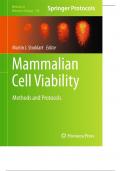Case
Mammalian Cell Viability Methods and Protocols Methods in Molecular Biology 740
- Institution
- Teachers College, Columbia University
Viability of cells is one of the most fundamental measurements made during studies in cell biology. Whether the question is one of basic cell survival, or whether it is being used to correlate cell number to some other factors such as matrix synthesis, an estimate of cell viability is universall...
[Show more]



